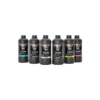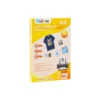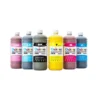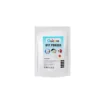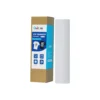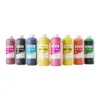A normal set of complete printing process is not easy to appear similar phenomenon, but if you ignore the details, the situation is different.
This blog tries to find out for you the possible problems and some effective ways to do it. Please scroll down to continue reading.

DTF Transfers Cracking: What’s Going Wrong?
First, you need to understand all the potential factors contributing to this issue. Perhaps it’s simply due to an incorrect setting, but it could also be caused by poor material quality, or even a combination of both. Therefore, you need to see if any of these factors are relevant.
There are two types of cracking that can occur after DTF printing. One happens during the transfer process after printing, and the other is a “stretch” crack that appears after the entire printing process is complete. These are distinctly different issues; see below for more information: Stretch Cracking Of The Product After DTF Printing.
Incorrect Temperature and Pressure Settings
One of the most common causes of cracked DTF transfers is incorrect heat press settings. If the heat press temperature is too high, the ink on the film, which has been powder cured, will crack due to the temperature. Normally, a specific temperature is all that is needed to make a successful transfer. Cracking can occur with either too high or too low of an issue, and too low of a temperature can prevent proper bonding, resulting in a poor bond and cracking under pressure.
There is also the possibility that the part of the film that is not inked has gotten powder on it, causing cracking. See also: How To Deal With Partial Powder Adhesion In DTF Film?
What you can do: Ideal temperatures for DTF transfers are typically 145°C to 165°C, with the pressure adjusted to the material. Make sure to calibrate the heat press regularly for temperature consistency and clean the surface of the heat press as well.

Film warpage is also possible if you don’t give the right amount of pressure, see also: What is DTF Film Pattern Warpage and Pattern Jaggedness
Over-Curing or Under-Curing
Curing is the penultimate step in the DTF printing process by heating and adding hot melt powder to the film that has been printed with ink. If the curing time or temperature is not matched properly, the film may appear to be dry and cracks may form indirectly. Insufficient curing can lead to poor adhesion, while over-curing can make the ink too brittle.
Solution: Always follow a balanced cure time and temperature. Perform tests to fine-tune settings, especially when using different types of films or powders.
On a side note, some people use a heat press to cure DTF powder, which can work. However, I don’t recommend it. See: Not Recommend To Cure DTF Powder With Heat Press

Low-Quality Materials
Not all DTF films and inks and powders are created equal. Poor quality printing supplies can keep you from DTFing properly, causing the design to crack or peel over time. If you use cheap or outdated materials, the poor quality of the materials themselves can cause the transfer to crack. All of these items are subject to change under different environmental conditions.
Solution: Try doing a control test by purchasing a small selection of new supplies and then comparing the new supplies to the old ones in terms of transfer cracking. If the difference is significant, then you just need to replace the consumables. If there is no difference, then you need to consider the problem from other angles.
Poor Fabric Selection and Pre-Treatment
The fabric you use also plays an important role in whether or not your DTF transfers cracking. Stretchy fabrics such as spandex and certain polyester blends tend to stretch and can cause the design to crack after repeated wear. Most DTF printing is not recommended on fabrics that stretch too much. A substrate with a surface that is too rough or uneven may also cause the print to crack.
What You Can Do: Ensure you’re using fabrics suited for DTF transfers—cotton, cotton blends, and certain polyester materials work best. Pre-press your fabric to remove moisture before applying the transfer. This helps avoid issues like warping and cracking after the design is transferred.

Improper Handling and Washing Care
Cracking in DTF printing may not have occurred during the printing process. Cracking is normal for long print runs. However, printing supplies that are not strong enough to withstand washing can also cause cracking to occur at an increased rate. Poor washing conditions, such as using high temperatures or strong detergents, can cause prints to crack over time. Cracking is also common when clothing is exposed to sunlight for long periods of time or when it is subjected to wear and tear.
Solution: If the cracking is occurring under normal conditions of use, then this is something that cannot be fixed. What you need to observe in this case is how long has the cracking been going on? If it cracks early, then it is a sign that something may be wrong in some way when performing DTF printing. Then there is the advice on washing and care, wash DTF printed items in cold water and avoid using fabric softeners. Air dry the garment and do not use a high temperature dryer. These simple care instructions can greatly extend the life of the print and prevent cracks from forming.
See also: Can You Press DTF Sheets On Polyester?

Preventing DTF Transfers Cracking
If you wish to not experience this cracking at all, then you can refer to these tips below.
Use Quality Materials
As tempting as it might be to go for cheaper options, using high-quality DTF inks and films will save you in the long run. These materials are designed to provide superior adhesion and durability, making them far less prone to cracking.
- There are differences in the supplies made by different producers. It would be better to choose a quality producer whenever possible.
Also, please do not mix high-quality consumables. Consumables can also differ chemically from one another, which can lead to cracking. See also: Why You Should Not Mix DTF Supplies
Proper Equipment Calibration
Make sure your heat press is calibrated to the right temperature and pressure. Adjust your settings based on the material and transfer type. Performing regular maintenance on your equipment will keep it running smoothly and help avoid unnecessary cracks in the transfer.
- Before you print, you can do a simple test to prevent problems with your device.
Test Your Settings
Before committing to a large batch, always run a test on a sample fabric to check for cracking or peeling. This allows you to make adjustments to temperature, pressure, or curing times before applying it to your final product.
- When your settings are normal, there will be no problems during the testing phase. As shown below.

Store and Handle Materials Properly
Proper storage is key to ensuring your DTF materials stay effective. Keep your inks and films in a cool, dry place, away from direct sunlight and moisture. Sealing unused materials properly helps prevent contamination and degradation.
Improve Basic Knowledge of DTF Transfers Cracking
Some common sense related to DTF printing is effective in preventing cracking.
- The melting point of hot melt powder will be different according to the material. Low temperature powder 85-90 degrees melting point, regular specification PU powder melting point in the 100-110 degrees range. The baking temperature should be slightly adjusted according to the difference in temperature measurement of different heating and baking equipment, and the conventional setting is 0-20 degrees higher than the melting point.
- T-shirt transfer temperature this should be specific according to the process and materials and equipment to do different adjustments, the following parameters for different processes for reference.
- Lettering film transfer: 165 degrees, 12 seconds, pressure 4-5PA.
- Heat sublimation transfer: 210-220 degrees, 25 seconds.
- DTF film transfer: 145-165 degrees, 6-15 seconds.
Conclusion
By understanding the causes—whether it’s improper temperature, low-quality materials, or incorrect handling—you can take the necessary steps to prevent it. Proper calibration, testing, and careful selection of materials can go a long way in producing durable, crack-free prints.
To completely avoid cracking in DTF printing, knowing the above information is just the beginning.
Accumulating long-term printing experience is the best way to avoid it. This blog post also contains some personal experiences, and I am still learning. If you have different experiences, you are welcome to share them in the comments section.


